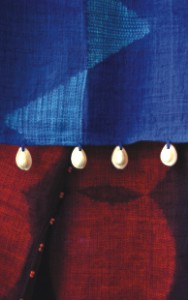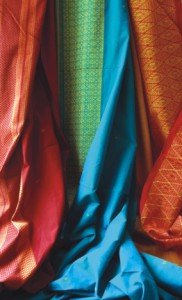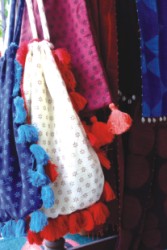|
Heritage
Something for Everyone
Srabonti Narmeen Ali
On any given day, the four stories of Prabartana buzz with activity. There is something for everyone on each floor, be it food items, clothes, books or even a café called the Woman's Adda Restaurant on the top floor. Here the women of Dhaka city are the majority, sitting on the comfortable floor mats and having a meal of ilish maach, lal chaaler bhaat and a variety of bhartas. The rule is that no man can come into this sanctum without being accompanied by a woman. Beyond the café in a small room sit Director of Prabartana Limited, Shahid H. Shamim and Namrata J. Shah, Textile Designer from India, discussing their plans for their newest line Nayab.
Nayab, an Urdu word for rare or unusual, is a collection that is based on and influenced by Mughal architecture, and designed by Namrata.
“I used a lot of emphasis on the mosaic look and the whole line is geometric in nature,” she says. “There are two distinct looks, one being cotton and the other being slightly richer in material -- silks and silk-cotton blends. There are also two aspects for different types of customers. The first is a more sophisticated type of work wear, for both men and women, which is not very run of the mill and more well thought out and detailed. The other aspect, however, is more of an occasional, evening wear kind of look, which is for everyone.”
This is Namrata's fourth visit to Bangladesh as a designer for Prabartana. In fact the young designer started her career with Prabartana. She took a four-year textile design course in Shrishti Bangalore, India, specialising in weaving, and graduated in 2002, conducting her diploma project with Prabartana and launching her first collection, named 'Misty Waters,' in 2003. She has been coming back off and on to design for Prabartana ever since.
 Prabartana, first launched in December of 1989, is well known for endorsing local handloom fabrics. “We have only one principal,” says Shamim, “which is to promote the handloom fabrics of Bangladesh, be it jamdani, banarasi, tangail -- anything local which can be sold in our market. We have tried to incorporate different aspects such as publishing and the café where we serve different Bangladeshi delicacies. We have also made an effort from the beginning to never use polythene bags. We feel that, as citizens of this country, we have a strong responsibility to maintain the sovereignty and the economic growth in whichever way we are capable of doing so.” Prabartana, first launched in December of 1989, is well known for endorsing local handloom fabrics. “We have only one principal,” says Shamim, “which is to promote the handloom fabrics of Bangladesh, be it jamdani, banarasi, tangail -- anything local which can be sold in our market. We have tried to incorporate different aspects such as publishing and the café where we serve different Bangladeshi delicacies. We have also made an effort from the beginning to never use polythene bags. We feel that, as citizens of this country, we have a strong responsibility to maintain the sovereignty and the economic growth in whichever way we are capable of doing so.”
Despite the fact that Shamim and his colleagues are making an effort to promote Bangladesh and its culture, there are some obstacles that they have faced. “We don't have ready human resources, academic discipline or professionalism, which sometimes hinders us along the way,” says Shamim, “It can be very stressful on the administrative level because it is really hard to get things done.”
This lack of resources provided a challenge for both Shamim and Namrata, in trying to finish the Nayab line in only four months. the Nayab line in only four months.
“Communicating between India and Bangladesh was a big issue” says Namrata. “We had to do a lot of back and forth consulting on sms and email about the colour blanket that we were going to use before we started successfully doing production. It was difficult but because of my previous work I was given full freedom and liberty without any interference. I could make my own decisions and was able to do things which were not otherwise done in Prabartana before in terms of designs and fabrics. For example, I used the Mirpuri weavers.
“Also it is important to remember that the design process is very complicated and requires a lot of thought. First of all you have to choose colours, materials, techniques, all the while keeping in mind what kind of design will look good with it. You have to have a visual image from the very beginning.”
Working in Bangladesh has been an interesting experience overall for Namrata, who also designs in India. In comparison to the Indian fashion industry Namrata feels that while the fashion industry in India is much stronger, Bangladeshi fashion has come a long way from when she first came.
“Fashion awareness is growing in Bangladesh, and people are not wearing whatever you give

Namrata J. Shah |
to them,” she says. “In addition there are many indigenous groups whose fabrics and style are very fashionable and I hope people will give more attention to these indigenous groups and their fabrics in the future.” Shamim feels that part of the problem is that the young people of Bangladesh are very influenced by the outside world, namely India, when it comes to fashion.
“Because of the internet, TV and music there is an overall international influence on the young population,” he says “The dictation is coming mainly from the media. Our focus is to see the new trends around the world and try to make something different and more significant to our culture and who we are. We will try to keep the basics but experiment with the overall design in terms of fabric and techniques. The thing is that Bangladesh is much richer in fabrics and handloom, but India is more industrial and as a result, they are able to market their stuff better. We need to get to that point.”
Although Bangladesh may have a long way to go, it is safe to say that stores such as Prabartana, which focus on promoting our culture and tradition, while also trying to move with the times, is doing a great service to our country. In addition to providing a getaway for those who need it, be it in the Adda Restaurant, or even the quiet, comfortable library on the third floor, it is also attempting to bring our fashion up to international standards, while staying true to our roots.
Copyright
(R) thedailystar.net 2008 |
